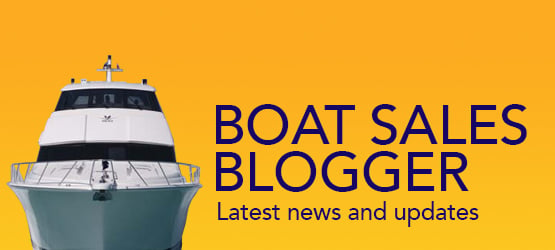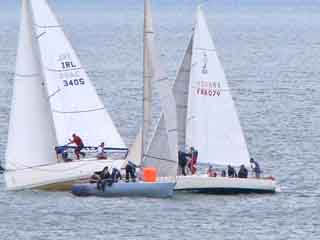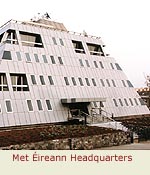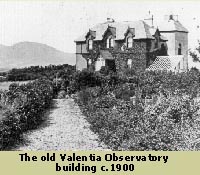History
The Royal Alfred Yacht club is much more than a quaint old Dublin
institution. For generations it has been an umbrella organisation,
linking yacht racers from the rival harbours of Dun Laoghaire and
Howth. It provides an attractive programme of regattas, complementing
more local and national events.
The 'Royal' in the title tells us that the club is long
established. But without the focus of a clubhouse, even some non-racing
Dublin based sailors might find it hard to recognise where it fits
in.
"The world's oldest specifically amateur yacht club (founded
1857)"
The 'Alfred', as it's locally known, actually played
a seminal role in the evolution and formation of racing in sailboats
worldwide. Some older established clubs trumpet their seniority
as their main, and maybe their only claim to fame, but the Royal
Alfred Yacht Club has a far greater and better deserved list of
accomplishments and real contributions to the sport. A short list
of its "firsts" clearly places the club as the original
model for yacht clubs worldwide, to a much greater extent than most
older clubs.
So Dublin's Royal Alfred Yacht Club is quite simply:
The world's oldest specifically amateur yacht club (founded
1857)
The world's first offshore racing club (1868-1922)
The first club to organise single and double handed yacht races
The prime mover behind the formation of the world's first national
yacht racing organisation (1872)
And finally, its two flag officers are credited with the authorship
of the first national yacht racing rules, which are at the core
of today's racing rules worldwide.
What other yacht club or sailing organisation, anywhere in the world,
can claim to have given more to the formation of the sport of sailing
as our Royal Alfred Yacht Club?
The record shows that taking the lead and giving a practical example,
our small club can reasonable be described as the first yacht club
of the modern era, in the universal meaning of a club for members
who actively sail their own boats.
"The world's first offshore racing club (1868-1922)"
How did a small group of middle class Dubliners make such a difference?
When they met in 1857, the objective of the 17 founder members was
"to encourage the practise of seamanship and the acquisition
of the necessary skill in managing the vessels". Translating
these stilted phrases, this meant that as far as practical, the
club would cater for those yachtsmen, and later yachtswomen, who
were prepare to sail and race their complex and heavy craft themselves.
Today's sailors may say 'so what?' but 141 years ago,
this was revolutionary stuff. The average yachtsman of that time
would no more think of trimming a sheet or hauling on a halyard,
than of digging his vegetable patch, or engaging in other obviously
menial tasks. An earlier fashion in the 1830s for establishing yacht
clubs had resulted in a rash of "Royal" clubs in most
provincial centres around the coasts of Britain and Ireland. Dublin,
Belfast and Cork, each followed the trend. However they were mainly
social clubs, often meeting only a few times a year, and they organised
very few events on the water, in some cases a regatta only every
second year. The yachts owned by the members of such clubs were
crewed by mere seamen, of a very different social status to the
"yachtsmen"!
How very different the men of the "Alfred", or the "Irish
Model Yacht Club" as they called their club at first. This
was not model as meaning scale models yachts, but "Model"
in the other, more Victorian meaning of the word, as something to
be emulated. They started by organising day cruises in company,
manoeuvring under orders from a flag officer. In this activity,
they were following the old custom of the first yachtsmen in Amsterdam,
back in the 1600s, and later copied by the gentry of Cork harbour
in the early 1700s. But of course the difference in 1857 was that
now the owners and their amateur friends were actually sailing themselves.
Very soon it was clear that the practical competence of the Dublin
yachtsmen was such that they could race. Any one who races will
readily agree with the saying that one learns more about skilful
boat handling in a season's racing than in ten seasons "messing
about in boats". But racing then was not as easy as today.
Press reports of yacht races back in the 1860s routinely mention
the "carrying away" of topmasts and bowsprits, and sails
splitting. In those days, all the materials were suspect. Hulls,
ropes, sailcloth, ironware, everything could and did break, but
you were expected to be sufficiently good a seaman as to be able
to cope, and without an auxiliary to get you home!
The Club quickly gained recognition, not only for its premier role
as the leading amateur club, but also with the prestige of a royal
warrant, acquiring the title it still carries: "Royal Alfred
Yacht Club". Queen Victoria's third son Prince Alfred, was
a naval officer who allowed his name to be used but he apparently
had no active connection with our club, or with our sister club,
the Prince Alfred Yacht Club of New South Wales.
"The first club to organise single and double handed yacht races"
Throughout the 1860s and 70s, our Club fired off an amazing series
of initiatives, which caused our club to be described as the Premier
Corinthian club. Indeed it started a new wave of yacht club formations,
with "Corinthian" in their name, which appeared in all
the major yachting centres around this time. Corinthian is another
word for amateur, because it was believed that in ancient Greece,
the athletes of Corinth competed for no reward other than a laurel
wreath. Yet the Victorian sailors were quite happy to race for large
cash and silverware prizes, which they kept! For them, the mortal
sin was to be paid to sail or race. At the end of each season, Hunt's
Yachting Magazine published a list of racing results for all the
yacht races in the British Isles, and also the total value of the
prizes awarded by the various clubs. The Royal Alfred Yacht Club
regularly featured in the top three of such prestigious clubs, and
in 1877 it ranked number one, with £712 in prizes for 11 races,
equivalent to about IR£40,000 today!
Three years earlier, the Royal Alfred's circular to all the British
yacht clubs, calling for a consistent regulation of handicapping
by means of measurement by a professional, and the Club's earlier
publication of yacht racing rules and time allowance tables, were
the trigger for the founding of the Yacht Racing Association which
became the Royal Yachting Association. Again typical of the Royal
Alfred's central role in this process is that its two flag officers,
Henry Crawford and George Thomson, are credited with the principal
authorship of the YRA's Racing Rules.
"The prime mover behind the formation of the world's first national
yacht racing organisation (1872)"
Its it tempting to dwell on the Royal Alfred's period in the spotlight,
but one has to admit that the Club could not maintain this momentum.
Its base was always yacht racing in Dublin Bay, and the Irish Sea,
and as Dublin declined in relative terms, deferring to the Clyde
and the Solent, and as larger racing yachts demanded professional
crew, the Corinthian ideal became less important for the top competitions.
So yachting in Dublin settled into a familiar pattern of one design
racing, with the beautiful gaff cutter Dublin Bay 25 and 21 footers,
and the Howth Seventeens. In this, the Dublin sailors were following
the lead of their dinghy sailing friends who, in 1887, had founded
the world's first one design class, the Water Wags. The twin harbours
of Dun Laoghaire and Howth both continued to provide that great
luxury, the facility to be sailing on one's yacht at 6pm, after
leaving the office at 5. Few other yachting centres could provide
this continuity, and so changes to new venues and new classes were
less necessary for the sailors of Dublin.
Eventually, the wheel came full circle and the sailing world rediscovered
one design racing in the 1930s, and even more so in the 1950s. By
this time, the Royal Alfred's pioneering contributions to the sport
were long taken for granted. Even offshore racing had to be reinvented
in the late 1920s, even though the "Alfred's" tradition
of 60 mile cross channel handicap races had been consistently maintained
as part of its annual race programme for 57 years (1867-1924).
"RAYC's two flag officers are credited with the authorship
of the first national yacht racing rules, which are at the core
of today's racing rules worldwide."
So the Club has played a key role in the formation of our sport,
as it is routinely practised around the globe. Throughout its 141
years, the Club has remained true to its founding principles, and
as the rest of the world came to follow this example, we may reasonable
claim that the Royal Alfred Yacht Club is not just the world's oldest
amateur yacht club, but also the oldest yacht club in the modern
tradition.
Royal Alfred Yacht Club
Have we got your club details? Click here to get involved































 Courtown Sailing Club is a family orientated and vibrant club where new members are always welcome.
Courtown Sailing Club is a family orientated and vibrant club where new members are always welcome.
 Operational Meteorology might be said to have begun in Ireland on 8 October 1860, when the first 'real time' weather observation was transmitted from Valentia Island in Co. Kerry. Valentia Observatory, as it came to be known, was one of a network of weather stations established around the Irish and British coastlines, by the naval authorities in London, to enable storm warnings to be provided for ships at sea.
Operational Meteorology might be said to have begun in Ireland on 8 October 1860, when the first 'real time' weather observation was transmitted from Valentia Island in Co. Kerry. Valentia Observatory, as it came to be known, was one of a network of weather stations established around the Irish and British coastlines, by the naval authorities in London, to enable storm warnings to be provided for ships at sea. Radar Antenna at Shannon AirportThe late 1940's and the 1950's were a time of rapid expansion for the Service. This period saw the establishment of a balanced nation-wide network of observing stations, manned on a full-time basis by Meteorological Service personnel. The climatological and rainfall observing networks were greatly enhanced, thanks largely to the willing co-operation of the Garda authorities around the country and the assistance of other Government Departments and State-sponsored bodies. At Valentia Observatory, which had moved to a mainland site near Cahirciveen in 1892, upper air radiosonde measurements began and a wide range of geophysical measurements and environmental monitoring activities was introduced.
Radar Antenna at Shannon AirportThe late 1940's and the 1950's were a time of rapid expansion for the Service. This period saw the establishment of a balanced nation-wide network of observing stations, manned on a full-time basis by Meteorological Service personnel. The climatological and rainfall observing networks were greatly enhanced, thanks largely to the willing co-operation of the Garda authorities around the country and the assistance of other Government Departments and State-sponsored bodies. At Valentia Observatory, which had moved to a mainland site near Cahirciveen in 1892, upper air radiosonde measurements began and a wide range of geophysical measurements and environmental monitoring activities was introduced.

































